|
|
|
Sort Order |
|
|
|
Items / Page
|
|
|
|
|
|
|
| Srl | Item |
| 1 |
ID:
123068
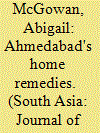

|
|
|
|
|
| Publication |
2013.
|
| Summary/Abstract |
Long known as innovative in modernist architecture, mid century Ahmedabad was also pioneering in another area of built form: housing. Starting in the 1920s when Indians seized control of urban politics, Ahmedabadis launched a number of bold new initiatives to improve housing in the city, involving a striking range of actors-labour activists, middle-class reformers, mill owners, and municipal leaders. Largely ignored under earlier British leadership, housing became a key way for Ahmedabadis to lay claim to a new, more inclusive vision of the city. Although housing continued to play a prominent role in politics after Independence, the 1950s actually marked a retreat from that earlier inclusive vision, ultimately enshrining the class and community segregation that marks Ahmedabad today.
|
|
|
|
|
|
|
|
|
|
|
|
|
|
|
|
| 2 |
ID:
123064
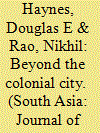

|
|
|
|
|
| Publication |
2013.
|
| Summary/Abstract |
It was long customary to begin essays on the historiography of cities in South Asia by mentioning the low level of scholarly interest once given to the study of urban pasts; 2 but a major corpus of work on this subject certainly now exists. In our view, the most important shortcomings of the existing body of scholarship now lie less in their neglect of historical urbanism than in the relative inattention given to a particular phase of urban history: the middle decades of the twentieth century. The historiography of South Asian cities has concentrated highly on what might be called 'the long nineteenth century', 3 a phase lasting from the establishment of British rule (which varied according to the region being discussed) to some point during the early twentieth century. Many of the richest works in the field confine themselves completely to nineteenth-century developments 4 or begin sometime during the late nineteenth century, edge into the initial decades of the twentieth century, and then end at some point in the 1920s or 1930s.
|
|
|
|
|
|
|
|
|
|
|
|
|
|
|
|
| 3 |
ID:
123069
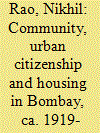

|
|
|
|
|
| Publication |
2013.
|
| Summary/Abstract |
From the late 1910s onward, co-operative housing societies in cities like Bombay offered affordable housing by using the agency of community to protect against the vicissitudes of the market. At the same time, ideas of urban citizenship premised on the liberal individual received greater attention with a broadened franchise and became increasingly linked to social rights such as affordable housing. While the community and the individual are seen as opposed to one another in the discourse of citizenship, this paper suggests that they mutually informed and constituted one another between 1919 and 1980 in ways that have enduring significance for understandings of urban citizenship.
|
|
|
|
|
|
|
|
|
|
|
|
|
|
|
|
| 4 |
ID:
123071
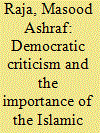

|
|
|
|
|
| Publication |
2013.
|
| Summary/Abstract |
Relying on major debates in reception and reader response theory, this essay attempts to explore the possibilities of reading metropolitan texts about Islam and Islamic culture with an understanding of the Islamic modes of meaning-making and interpretation. Geared toward scholars and students of literature and culture, the essay hopes to foster a more nuanced and complex approach to reading texts that appropriate Islamic raw materials in order to represent a mostly Western poetics and politics.
|
|
|
|
|
|
|
|
|
|
|
|
|
|
|
|
| 5 |
ID:
123070
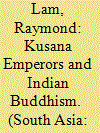

|
|
|
|
|
| Publication |
2013.
|
| Summary/Abstract |
This essay provides an updated evaluation of the diffusion of Buddhism throughout Eurasia during the Kuaa period (ca. 30 CE-375 CE). Recent studies and evidence have challenged established arguments about the nature of Buddhism in the Kuaa Empire. Perceptions have shifted about the role of the Kuaa rulers in the spread of Buddhism, while debate concerning Gandharan art has been renewed. This new overview will help to alert readers to the most important findings of recent years and the scholarly advances that have recalibrated specialists' understandings of the political, economic and cultural factors that defined the multilayered relationship between the Kuaas and India's Buddhist communities.
|
|
|
|
|
|
|
|
|
|
|
|
|
|
|
|
| 6 |
ID:
123065
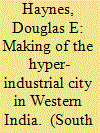

|
|
|
|
|
| Publication |
2013.
|
| Summary/Abstract |
This essay explores the rapid expansion of small handloom centres in Western India between 1930 and 1970. It attributes the transformation of these places into larger cities to the role of local weaver-capitalists, who developed new markets for local textiles and introduced significant technological innovations into the industry, and who forged strategies for combatting the growth of labour resistance. The essay also highlights the role of the late colonial and early post-Independence states, which promoted the growth of weavers' co-operatives and which imposed extensive regulations on larger enterprises. The paper argues that the powerloom centres of Western India sustained a 'hyper-industrial' quality, with limited economic or cultural diversification, restricted urban amenities and public services, and the extensive concentration of poor urban migrants in slums.
|
|
|
|
|
|
|
|
|
|
|
|
|
|
|
|
| 7 |
ID:
123066


|
|
|
|
|
| Publication |
2013.
|
| Summary/Abstract |
This article looks at the growth and expansion of Delhi during the eventful period 1936-59. It examines how the sovereign state came to acquire vast new legal powers to regulate the city, the economy and the polity through the course of managing World War II, the Transfer of Power and finally Partition. In the case of urban planning, the process of increasing state control over land, urban development and the built environment started specifically in 1937 with the establishment of the Delhi Improvement Trust and culminated with the formation of the Delhi Development Authority in 1957. At the same time the article also shows that despite this, Delhi's actual growth in this period often sidestepped state plans with the city's urban expansion being moulded by the impact of global events; emerging through the everyday actions of a vastly increased urban citizenry, especially following Partition, and also by the unexpected playing-out of increasing and exaggerated institutionalised state power itself, as described in the article.
|
|
|
|
|
|
|
|
|
|
|
|
|
|
|
|
| 8 |
ID:
123067


|
|
|
|
|
| Publication |
2013.
|
| Summary/Abstract |
This paper examines the rise of urban space as locus of intervention, and planning as modality of state power in South Asia from the late nineteenth century to the early post-colonial period. I view these developments through the re-making of Hyderabad, a major metropolis and capital of a sovereign non-colonial state until 1948. The regime's autonomous status made the city a venue for political experimentations informed by varied global and regional circuits. A particular develomentalist idiom fusing an older ideology of ethical patrimonialism and emerging technocratic legitimising rhetorics underwrote planning work in Hyderabad. Tracing urban expansion, housing and infrastructural development, and state-led economic planning schemes, I suggest Hyderabad exemplifies the emergence of a crucial and enduring new form of power in South Asia.
|
|
|
|
|
|
|
|
|
|
|
|
|
|
|
|
|
|
|
|
|